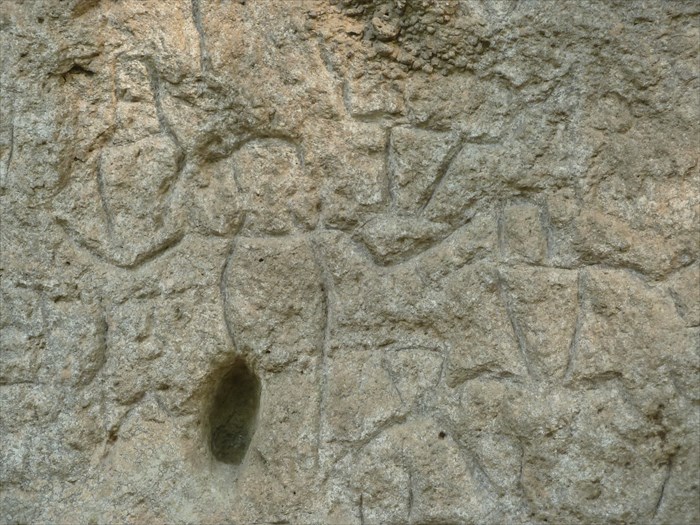
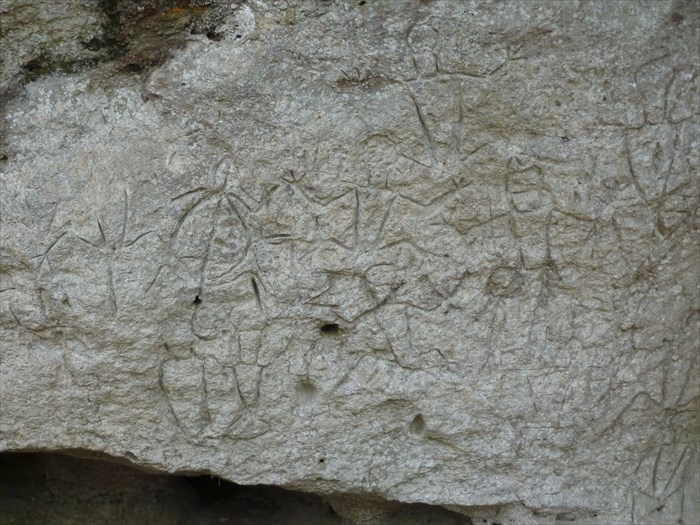
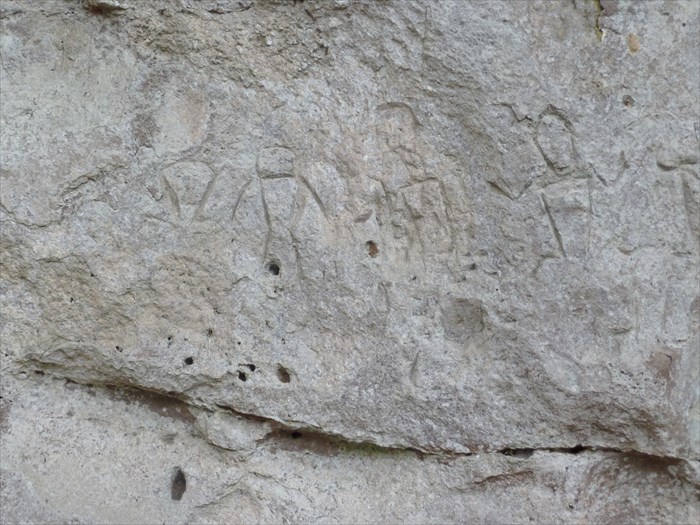
There is still a lot of research to do about these petroglyphs, on an open face of rock wall, only partially protected by an overhang, and largely exposed to erosion by the elements. Many of the figures are still clearly visible, some depicting human forms, and others lizards or other animals more difficult to identify. Not much is known about the inhabitants who might have created these up to 5,000 years ago. They are the oldest work of art known to exist in the Philippine islands.
Amazingly, although only about 25-30 miles from central Manila, these went undiscovered until 1965 when they were found by Carlos V. Francisco, already recognized as one of the country's leading artists. It was his keen artist’s eye, while leading a troop of boy scouts, that recognized these etchings for what they were, as they were known locally. Unfortunately, no steps were made to protect them and vandalism in the ensuing years resulted in the destruction and defacing of some of them which is clearly visible. In 1996 a presidential decree designated the site as a national cultural treasure. Finally archaeological teams for the Philippine National University began conservation measures. A more detailed analysis can by Enrico Dee can be seen on his site, Exploring the Pre-Historic Angono Petroglyphs. It is now a tentative Unesco Heritage Site.
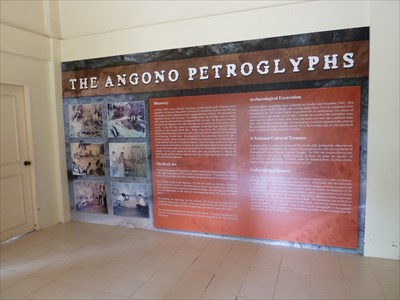
THE ANGONO PETROGLYPHS
Discovery
In March 1965, Carlos “Botong” Fancisco, a noted muralist and a National Artist reported to the National Museum the existence of a rockshelter located in the hills near the boundary between Binangoan and Angono, province of Rizal. The rock-wall was reported incised with drawings. According to him, the drawings were of various types: frog-like and lizard-like, and appeared to be very old. The discovery was quite accidental and happened when Mr. Francisco was on a field trip with a troop of boy scouts. In the hills they rested in a rockshelter which had been used by Filipino guerillas of the Second World War. While they were lying down, Mr. Francisco noticed deeply-etched lines high on the rock wall, which upon closer inspection, he discovered to be drawings of some kind. He recognized in these drawings what artists call, a primitive quality. Being uncertain, he withheld any conclusion until he had reported it to the National Museum for proper evaluation. Upon his return to town, he inquired from among the old residents of Angono for any information about the rockshelter. He was told that there really were drawings known to be in the rockshelter in the hills but that nobody in town, even among the old folks, gave any significance to them at all. Realizing the possible cultural and historical value of these drawings, he reported the find to the National Museum.
The Rock Art
The site of the Angono Petroglyphs is a shallow rockshelter measuring about 63 meters wide, eight meters deep and five meters at the highest point. It is formed in volcanic tuffs of the Quaternary, the shelter probably having been created as a result of faulting.
One hundred twenty seven drawings (127) are still visible in the form of animate figures, generally a circular or domelike head on top of a vee-shaped torso. The flexed arms and legs are linear sometimes provided with digits. The drawings are distributed on a horizontal plane on the rock wall area measuring twenty five meters by three meters
The drawings are engravings into the volcanic tuff which was soft enough to be worked by a denser piece of stone. Of the one hundred twenty seven figures, fifty one are distinct types, suggesting that the engravings were done by many individuals.
The Angono petroglyphs are comprised of static figures. The engravings appear to be product of an associated ritual where the subject is depicted as the object of some affection.
Achaeological Excavation
Archaeological excavations were conducted on October and November 1965. Test trenches measuring 4 x 5 meters with varying depths from 15 to 30 centimeters were excavated in the site yielded highly fragmented bits of earthenware, two pieces of obsidian flakes, and another two of chert. Outside the mouth of the rockshelter were uncovered two pieces of flake stone tools, one stone core tool and a polished stone adze with a blunted working edge. The association of artifacts suggests a date prior to the introduction of metals into the country that is the Neolithic Age, in what may be at least a millennium before the birth of Christ.
A National Cultural Treasure
In August 1973, by virtue of Presidential Decree No. 260, declared the oldest known work of art in the Philippines, the Angono Petroyglyphs on the wall of a rockshelter in Binangonan, Rizal, a National Cultural Treasure. In 1985, the Angono Petroglyphs have been included in the World Inventory of Rock Art under the auspices of UNESCO, ICOM, ICOMOS, ICCROM, under the Standard Rock Art Files (RAS), together with other world famous prehistoric rock art.
Cultural Significance
The Angono Petroglyphs site is culturally significant because of a series of historic aesthetic, scientific and social values ascribed to it. Historically, the site represents probably the oldest rock art in the Philippines which is unique in being executed with a deep engraving technique. It has scientific value for further investigation of its cultural context and date, its place in local folklore, and in its ecological interest for being situated in a relict forest area. The aesthetic value of the anthropomorphic engravings and their forested environmental setting is high. The rockshelter site itself has a social value, having long been known to local people and having various traditions associated with it. The symbolic value of the Angono petroglyphs is increasingly important to the Filipino people as an outstanding example of their heritage that has few parallels within Southeast Asia.
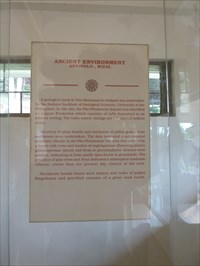
ANCIENT ENVIRONMENT
ANTIPOLO, RIZAL
A geological study in Tres Hermanas in Antipolo was undertaken by the National Institute of Geological Sciences, University of the Philippines. In this site, the Pilo-Pleistocene deposit was identified as Laguna Formation which consists of tuffs deposited in an alluvial setting. The radio-metric datings are 1.7 and 1.0 million years.
Recovery of plant fossils and extraction of pollen grains from sediments were undertaken. The data indicated a sub-tropical moderated climate in the Pilo-Pleistocene. The area was covered by a forest with trees and bushes of angiospermae (flowering plants) gymnospermae (pines) and ferns or pterydophytes. Grasses were present indicating at least partly open forest or grasslands. The presence of pine trees and ferns indicated a subtropical moderate climate, cooler than the present day climate of the area.
Vertebrate fossils found were molars and tusks of pygmy Stegodonts and petrified remains of a giant land turtle.
Today there is a small visitor center and museum at the site. A path with an elevated viewing platform makes it easy for visitors to get close to observe these ancient drawings etched into the stone. For a panoramic view of the petroglyphs from the viewing platform, see Angono Petroglyphs from 360 Cites Net.
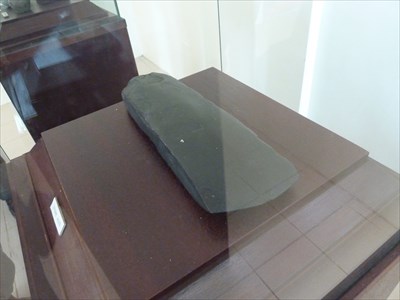
STONE ADZE
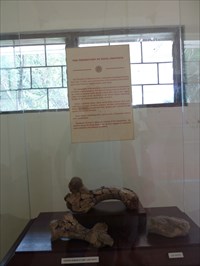
Petrified remains of a giant land turtle and leaf remnant
THE PREHISTORY OF RIZAL PROVINCE
The Province of Rizal was once a vast land occupying the areas where the 15 cities and municipalities of the northern and eastern part of the National Capital Region now stand.
The topography of the province is characterized by a combination of valleys and mountains. The flat low lying areas are located in the western section while gently rolling hills and a few rugged ridges form part of the foothills of the Sierra Madre Mountain Ranges in the eastern portion of the province.
About a million years, these areas were covered with lush vegetation of trees, bushes, grasses, shrubs, pines and ferns where prehistoric animals browsed, grazed and wallowed in its ponds, rivers and streams.
Later about a millennium B.C., settlement of Neolithic Culture were established.
Hundreds of years before the coming of the Spaniards, the settlers along the Pasig River were already engage in extensive trade relations with ancient countries
Access to this site can be a challenge. This outcropping is located along the boundaries of Angono, Binangonan and Antipolo of the province of Rizal about 30 miles east of central Manila. Actually, it lies between the cities of Angono on the coast, and Antipolo higher up the mountains. The road up from Angono is steep and curvy, and the approach from Anitipolo is likewise steep. Some local taxi and motorcycle operators may not even know where it is. Tricycles, so common in the Philippines, are NOT recommended on this road!
There is no sign or other direction at the road. There is a gravel area for parking, but it looks like a gravel storage site more than the entrance to a National Cultural Heritage Site. The only access from here is through a rough-hewn, unlit tunnel about 150 feet long. The trail beyond here leads another couple hundred feet to the visitor center/museum. The short trail begins outside the entrance.
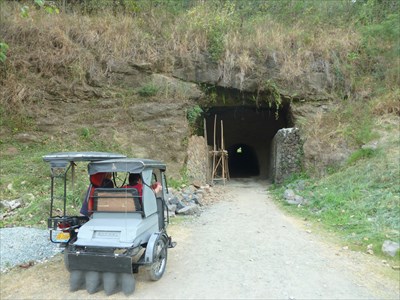
Parking area and entrance to the tunnel to the petroglyph site
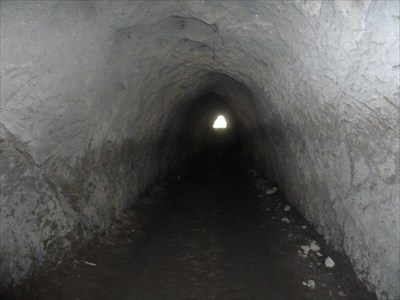
Still under improvement there is no light in the tunnel - except at the end!
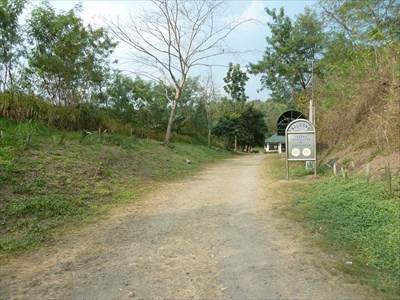
The path from the tunnel to the museum and viewing area.
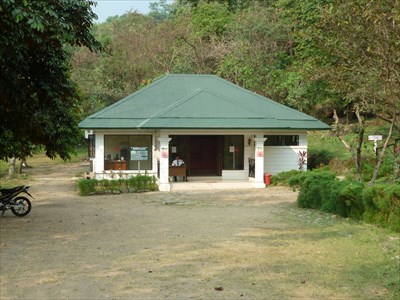
The National Museum for the Angono Petroglyphs

National Museum
Angono Petroglyphs, Binangonan, Rizal
The Angono Petroglyphs is considered a highly significant cultural landmark because it is the oldest known work of art in the Philippines. It is included in the list of the National Cultural Treasure of the country and World Inventory of Rock Art. It was also declared as one of the most imperiled historic sites in the world by the World Monuments Watch and the World Monuments Fund.
Human and animal-like figures are engraved on the rockwall made of volcanic tuff. These figures are considered the oldest known art works in the Philippines, dating back to circa 3,000 B.C.
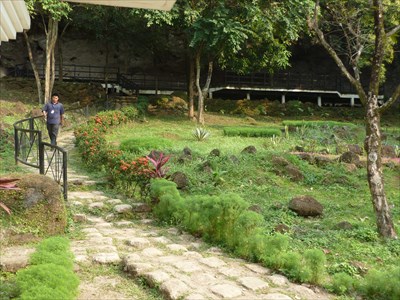
From the museum a short path leads to the petroglyphs.